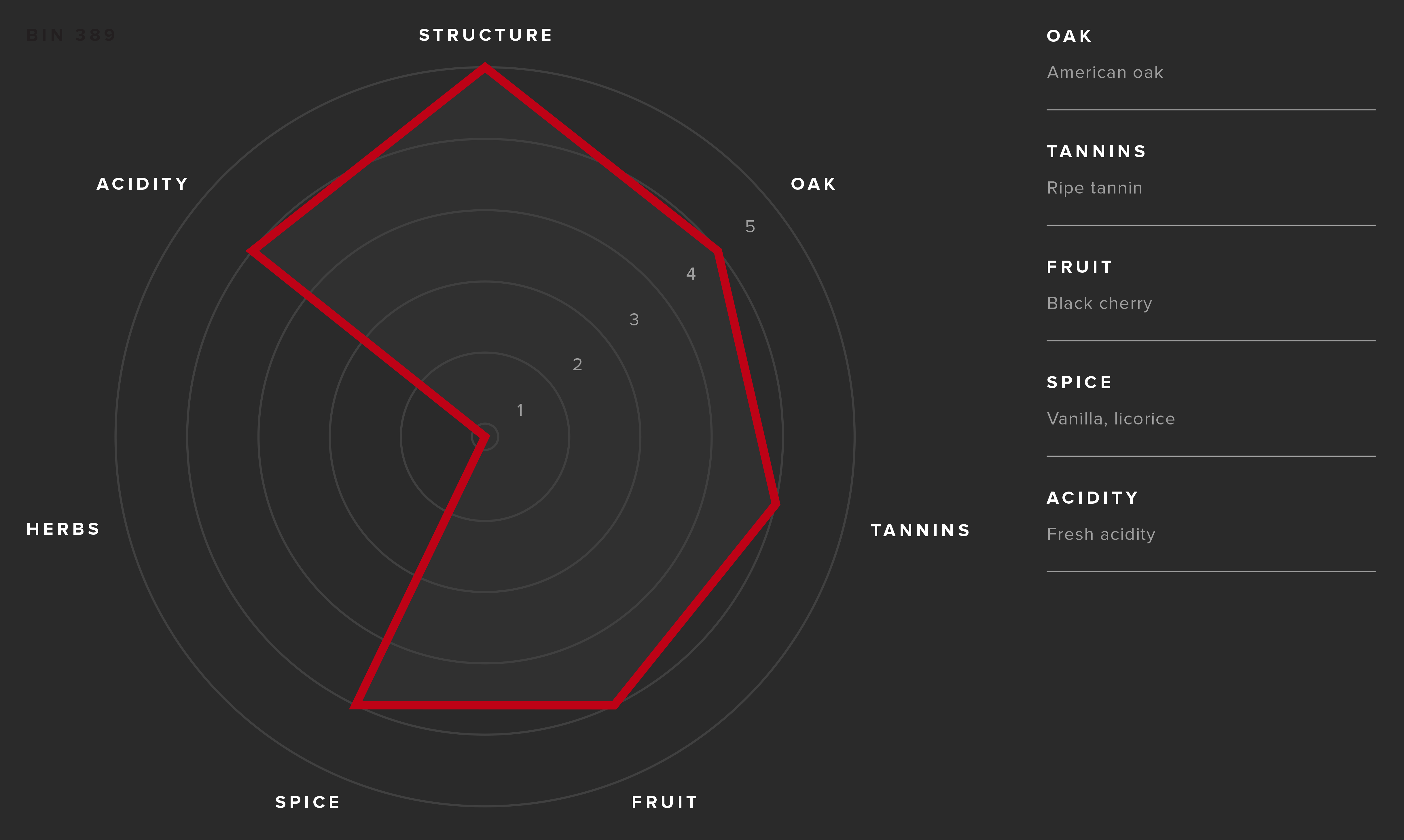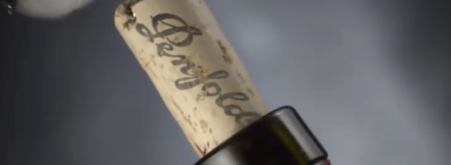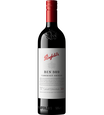一起开启您的传奇吧。
Bin 389 Cabernet Shiraz 2020
Australian Release
Bin 389 Cabernet Shiraz 2020
Bin 389 was often referred to as ‘Baby Grange’, in part because components of the wine are matured in the same barrels that held the previous vintage of Grange. First made in 1960 by the legendary Max Schubert, this was the wine that helped forge Penfolds reputation with red wine drinkers by combining the structure of cabernet sauvignon with the richness of shiraz. Exemplifying the judicious balance of fruit and oak, Bin 389 highlights the generous mid-palate Penfolds in known for.
| 种类
Cabernet Sauvignon Shiraz
|
Cabernet Sauvignon Shiraz |
|---|---|
| 年份
2020
|
2020 |
| 容量
750 mL
|
750 mL |
| Closure
Screw Cap
|
Screw Cap |
| 最佳品鉴期
2023 – 2050
|
2023 – 2050 |
Bin 389 was often referred to as ‘Baby Grange’, in part because components of the wine are matured in the same barrels that held the previous vintage of Grange. First made in 1960 by the legendary Max Schubert, this was the wine that helped forge Penfolds reputation with red wine drinkers by combining the structure of cabernet sauvignon with the richness of shiraz. Exemplifying the judicious balance of fruit and oak, Bin 389 highlights the generous mid-palate Penfolds in known for.
“ Synergistic composition of cabernet sauvignon and shiraz, enveloped in American oak – familiar yet refined."
- Andrew Baldwin, Penfolds Winemaker
| 19/20 Points - Matthew Jukes |
| 97 Points - Andrew Caillard MW |
| 97 Points - David Sly, Decanter Magazine |
| 97 Points - Tony Love |
| 96 Points - Tyson Stelzer |
Andrew Caillard | The Vintage Journal
"Deep crimson. Lovely blackberry, blackcurrant, dark plum aromas with roasted chestnut, chinotto, dark chocolate notes. Generously concentrated and beautifully integrated wine with plentiful blackberry, blackcurrant, fruits, fine slinky/ chocolaty, hint al dente/ bittersweet tannins, superb mid-palate volume, some inky complexity, lovely mocha/ espresso oak notes and fresh long juicy acidity. Builds up claret firm with graphite minerally notes. Very impressive extract, density and torque. A reference Penfolds wine. McLaren Vale, Barossa Valley and Padthaway. 12 months maturation in American (33% new) and seasoned oak hogsheads. Drink 2025–2038. 14.5% alc"
David Sly & Georgie Hindle | Decanter
"The superb quality of fruit allocated in this luscious blend – dubbed by many as 'baby Grange' – represents probably the best value to be found in the Penfolds portfolio and is the shining star of the reds in the 2022 Collection. Its rich and plush mixture of plum, black cherry and mulberry flavours are slapped into line by a stern tannin drill sergeant, so that it finishes cleanly and absolutely correctly. Generous, approachable and complete, it tells a very satisfying wine story. Released at A$100/bottle. Drinking Window 2022 – 2045 – 97 points"
James Halliday | Wine Companion
"Blend of cabernet sauvignon and shiraz (51/49%) sourced from vineyards in McLaren Vale, Barossa Valley and Padthway. Matured for 12 months in American hogsheads (33% new). Coming back to this Australian battler after Penfold's Napa and Bordeaux trials was something of a rude shock in the first instance. This is big, bold, beautiful and quintessentially Australian. It makes no apologies for its wealth of black fruits, almost succulent tannins, and vanillin oak."
TASTE PROFILE


Deep garnet core, crimson rim.

Tightly coiled. Sweet American oak evident – baking spices, icing sugar dusting. Italian Crostoli, cinnamon scrolls, Madagascan vanilla bean. The fruit has such density, the yin and yang of cabernet and shiraz, a Penfolds staple. No tussle for varietal supremacy, harmonious. Traditional German Kuchen (cake shop) sweet treats, walnut torte with ganache frosting, raspberry coulis, pouring cream. Fresh black cherries and ripe black plums. From the savoury sphere, hints of seared wagyu seasoned with cracked pepper. Sundried tomatoes, salsa verde and kalamata olive tapenade.

A well-defined focus on palate. Forward facing – line and length. The fascinating interplay between cabernet sauvignon and shiraz providing not only considerable length and structure, but also width and density. Result... completely filling the palate. Always anticipated, a trademark creamy Bin 389 mid-palate. A wine with much to offer even in the flush of youth. Complexing flavours: savoury nuances of freshly sliced fennel, pan wilted radicchio leaf and pickled turnips. Moroccan lamb backstraps on eggplant relish. Red liquorice and cherry provide a sweet counterpoint. Evolved tannins seamlessly drive the palate structure. Will last many decades, if you can wait that long.
Vintage Conditions
South Australia experienced the second consecutive year of winter drought. Spring was cool and dry, conditions that continued well into November delaying flowering and fruit-set. With root-zone moisture levels well below average, irrigation was vital. Padthaway and the Barossa Valley experienced frosts in September that affected yields. The 2019 calendar year was the driest on record in the Barossa Valley. The beginning of summer was marked by a state-wide heatwave. In all, the Barossa Valley had 26 summer days recorded over 35°C. Conditions in January and February provided some welcome relief. McLaren Vale had above average rainfall in February, which ensured the vines were able to finish the remainder of the season in good shape. While bunch weights and berry numbers were low across the three regions, the harvest produced some outstanding parcels of grapes.
| GRAPE VARIETY
51% Cabernet, 49% Shiraz
|
51% Cabernet, 49% Shiraz |
|---|---|
| VINEYARD REGION
McLaren Vale, Barossa Valley, Padthaway
|
McLaren Vale, Barossa Valley, Padthaway |
| 葡萄酒分析
酒精浓度: 14.5%, pH: 3.61, Acidity: 6.5g/L
|
酒精浓度: 14.5%, pH: 3.61, Acidity: 6.5g/L |
| MATURATION
12 months American oak hogsheads (33% new)
|
12 months American oak hogsheads (33% new) |
The Bin 389 Story
Bin 389 is one of Australia’s great cellaring red wines. First produced in 1960, its history is connected with the development of Grange and Max Schubert’s ambition of creating a ‘dynasty of wines which all bear an unmistakable resemblance to each other’. Named after its original binning compartment at Magill cellars, Bin 389 is the most popular wine in the Australian secondary wine market because of its heritage, consistency and reputation.
Discover Collection


